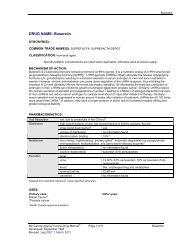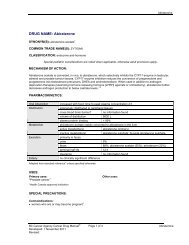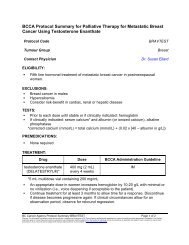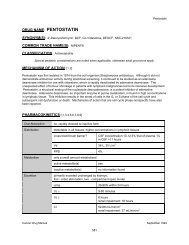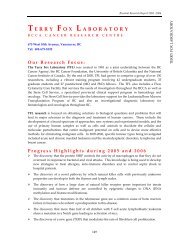CCSP manual - BC Cancer Agency
CCSP manual - BC Cancer Agency
CCSP manual - BC Cancer Agency
You also want an ePaper? Increase the reach of your titles
YUMPU automatically turns print PDFs into web optimized ePapers that Google loves.
Human Papilloma Virus and Cervical <strong>Cancer</strong><br />
The detection of Human Papilloma Virus (HPV)<br />
in the majority of cervical cancer precursor<br />
lesions and invasive cervical carcinomas supports<br />
epidemiological data linking this agent to cervical<br />
cancer. More than 80 types of HPV have been<br />
identified. Approximately 30 types are transmitted<br />
sexually and can infect the cervix. About half of<br />
the sexually transmitted types have been linked to<br />
cervical cancer, some (such as HPV types 16 and<br />
18) more so than others. HPV infection of the<br />
cervix is very common however, and only a very<br />
small percentage of infected women will develop<br />
cervical cancer. The types of HPV which are<br />
associated with cervical cancer are rarely associated<br />
with visible genital warts. Some clinical studies to<br />
date have suggested a limited role for HPV testing<br />
in cervical cancer screening. At present, HPV testing<br />
is not part of British Columbia’s Cervical <strong>Cancer</strong><br />
Screening Program.<br />
In view of the evidence supporting the role of<br />
HPV infection in the pathogenesis of cervical cancer,<br />
vaccines to immunize against HPV infection might<br />
offer a primary cervical cancer prevention strategy.<br />
Vaccines utilizing HPV proteins to induce antibodymediated<br />
immunity are currently undergoing<br />
clinical trials.<br />
New Technologies<br />
Recent advances in gynecological cytology have<br />
focused on improving specimen preparation<br />
and processing and on the interpretation of<br />
cytological findings. They will lead to an increase in<br />
screening accuracy and subsequently improve the<br />
detection rate of pre-invasive and invasive cervical<br />
malignancies.<br />
Liquid-Based Cytology (Thin-Layer Cytology)<br />
The sample is collected with a spatula ± brush in the<br />
same way as for the conventional Pap smear. Instead<br />
of smearing the sample on the slide, the specimen<br />
is washed directly into a vial containing liquid<br />
fixative. Slide preparations are made from the liquid<br />
sample. The cells are fixed more uniformly, mucus is<br />
dissolved, large cell clusters are dispersed and debris<br />
and excessive blood are removed. Random cell<br />
disbursement allows for easier interpretation. Studies<br />
show that liquid-based cytology improves the<br />
detection of atypical cells and reduces the number<br />
of inadequate samples. However, it may increase the<br />
number of false positives. This method of specimen<br />
collection is more costly and transport is difficult.<br />
It is not currently available in British Columbia.<br />
Machine-Assisted Screening<br />
Computerized screening devices are algorithm-based<br />
decision making instruments. Some automated<br />
screening devices require specially prepared and/or<br />
stained slides, while others can use routinely stained<br />
smears. These machines can be used for primary<br />
screening or as re-screening devices. In the United<br />
States, where 10% of all negative slides must be<br />
re-screened, an automated device was shown to<br />
detect 2 – 3 times more false-negatives than <strong>manual</strong><br />
interpretation. In a primary screening mode, up<br />
to 25% of all slides from women with a low<br />
probability of having cervical precancerous lesions<br />
can be scanned by machine only without further<br />
intervention by a cytotechnologist.<br />
The B.C. Cervical <strong>Cancer</strong> Screening Program<br />
is currently preparing for a pilot project to assess<br />
the feasibility of implementing such devices in our<br />
screening program.<br />
10




